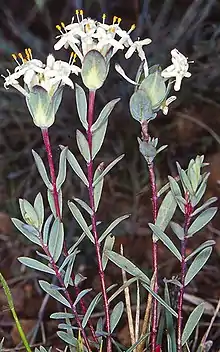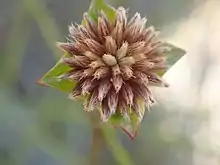Pimelea glauca
Pimelea glauca, commonly known as smooth riceflower,[2] is a species of small shrub in the family Thymelaeaceae and is endemic to Australia. It is not considered to be threatened.[3]
| Pimelea glauca | |
|---|---|
 | |
| Flowers | |
| Scientific classification | |
| Kingdom: | Plantae |
| Clade: | Tracheophytes |
| Clade: | Angiosperms |
| Clade: | Eudicots |
| Clade: | Rosids |
| Order: | Malvales |
| Family: | Thymelaeaceae |
| Genus: | Pimelea |
| Species: | P. glauca |
| Binomial name | |
| Pimelea glauca R.Br.[1] | |

Description
Pimelea glauca is a branching small shrub to 1 m (3 ft 3 in) high, thickly branched with smooth stems. The bluish-green leaves are arranged opposite, lance or linear shaped, 3–15 mm (0.12–0.59 in) long, 1–6 mm (0.039–0.236 in) wide ending with a downward curving, short, sharp point. The inflorescence consists of 7-35 creamy-white tubular flowers 8–14 mm (0.31–0.55 in) long in dense clusters at the ends of the branches. The 4 egg-shaped flower bracts are 6–16 mm (0.24–0.63 in) long, 2–8 mm (0.079–0.315 in) wide, smooth on the outside, hairy on the inside and the edges fringed. Flowering occurs mostly in spring.[2][4][5]
Taxonomy and naming
Pimelea glauca was first formally described in 1810 by Robert Brown and description published in Prodromus florae Novae Hollandiae et insulae Van-Diemen, exhibens characteres plantarum quas annis 1802-1805.[6] The specific epithet glauca is from the Latin word glaucus meaning having bluish-grey or green colour, referring to the leaves of this species.[7]
References
- "Pimelea glauca". Australian Plant Census. Retrieved 27 December 2019.
- Sharp, Sarah; Rehwinkel, Rainer; Mallinson, Dave; Eddy, David (2015). Woodland Flora-a field guide for the Southern Tablelands (NSW & ACT). Canberra: Horizon Print Management. ISBN 978-0-9944958-0-8.
- "Pimelea glauca R.Br". Atlas of Living Australia. Global Biodiversity Information Facility (GBIF). Retrieved 10 March 2016.
- "Pimelea glauca". VICFLORA-Flora of Victoria. Royal Botanic Gardens Victoria. Retrieved 27 December 2019.
- "Pimelea glauca". eFloraSA-Electronic Flora of South Australia. Retrieved 27 December 2019.
- "Prodromus florae Novae Hollandiae et insulae Van-Diemen, exhibens characteres plantarum quas annis 1802-1805". Biodiversity Heritage Library. Retrieved 27 December 2019.
- Sharr, Francis Aubie (2019). Western Australian Plant Names and their meanings. Kardinya Western Australia: Four Gables Press. p. 207. ISBN 9780958034180.